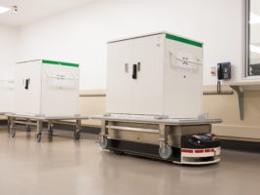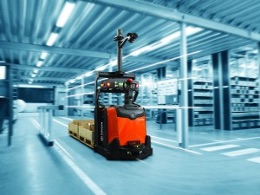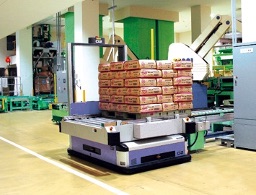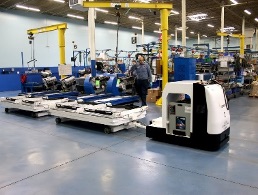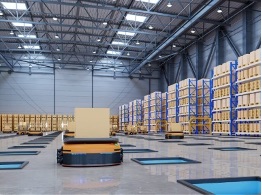RESOURCE
AGV & AMR
May be some of us are still not aware of this material handling solution, however, in fact, AGVs have been introduced since 1950’s and have quickly become a catalyst paving the way to intralogistics 4.0. Due to the rapid progress of industry revolution, companies have started to invest in innovative technology in order to keep businesses stay competitive in today’s industry. Just a quick heads-up for you, AGV is basically a material handling system that transport goods or materials throughout the warehouse, distribution center or manufacturing facility without human intervention or guidance.
In today’s market, there are several types of AGVs and are categorized according to the load requirements and transport methods.
Type of AGVs | Description |
Underride AGV
| Also known as automated guided cart (AGC). It is the most basic AGV type that lifts the loads by driving underneath the carts or shelves and lifts it slightly. It is often used in hospitals where it can effectively transport the compact loads such as food, medical supplies without the need for medical staff to push the cart manually from place to place. |
Forklift AGV
| Forklift AGV is simply a conventional material handling equipment such as counterbalance truck, pallet truck, stacker, reach truck, VNA, integrated with an AGV controller and a navigation system, which makes it able to operate without human control.
|
Unit Load AGV
| Unit load AGV is designed to transport one or several unit loads (unitized or palletized goods) to or from conveyors, stands and end-of-line equipment (palletizers, wrappers, etc.), as well as automated storage and retrieval system (ASRS). This is why unit load AGV normally equipped with transfer devices like conveyors, shutter system, lift platform as it does not lift the load off direct from the floor. |
Towing AGV
| Towing AGV is designed to pull or tow one or more undriven equipment like trailers or carriers. Unlike forklift and underride AGV, towing AGV does not involve any lifting, it is used to tow heavy loads over long distances. |
Autonomous Mobile Robot
| Known as AMR, a more sophisticated technology as compared to other types of AGV. In contrast with traditional AGV which moves according to the pre-assigned route, AMR is equipped with intelligent navigation which enable it to move in a versatile manner. |
Reference:
- Cruz, M. (2018, October 23). Quick Key Facts About Automatic Guided Vehicle Systems. MHI Blog.
- Taglic, N. (2021, October 15). Automated Guided Vehicles (AGV) Meaning & Types. 6 River Systems.
- Geekplus Technology Co., Ltd. (2021, October 6). 5 Questions to Ask when Choosing an AGV or AMR.
- Manufacturing.net. (2022, March 29). Types of AGVs and How to Choose the Right Ones for Your Company.
Today, more and more businesses nearly every industry are turning standard forklift into AGV or AMR for material movement. There is no doubt that implementing AGVs would eventually bring benefits to the operations, however, as a business owner may weigh the pros and cons between standard forklift and AGVs in order to decide which is more beneficial to your business.
Cost
As compared to standard forklift, of course AGVs have a higher upfront cost. However, why people are still considering to implement AGVs into their business? This is because AGVs are cheaper in long run. Just imagine salaries paid to the operators are never ended, while AGVs are the one-time investment. AGVs only required minimal human interaction which significantly reduce the labor cost. Apart of that, AGVs are able to work continuously 24/7 (disregarding downtime for repairs and reprogramming), and this could eventually substitute 2 or 3 operators, causing significant savings in labor cost.
Task Required
Depending on your operation, whether it is a repetitive job or non-repetitive job, will also become a consideration to decide which options make more sense. For a non-repetitive job, standard forklifts will be a better option in order to carry out job more efficiently as AGVs would have to be specially mapped and programmed. Also, standard forklifts are more flexible in handling pallets and loads with variety sizes. In contrast, AGVs are more efficient in doing repetitive job since the program would tell them where to load and where to unload the goods.
Working Environment
AGVs do provide a unique benefit as compared to standard forklift which is able to work in an extreme environment. They are ideal to use in an extremely cold weather, hot climate and also handling hazardous substances that are uncomfortable or unsafe for humans.
Safety
AGVs are much safer if compared with human-operated equipment. Reason being is AGVs are equipped with safety devices such as cameras, object detection, laser, warning lights and etc., allow them to operate safely around personnel and building structures. Whereas, for human-operated equipment is ultimately rely on the operators, and as we all know human always has the potential to get distracted or fatigued. This would eventually be causing injuries or accidents in the workplace.
IT Infrastructure
As we all know, AGVs vary in complexity and navigation systems, thus, before implementing AGVs into business operation, you have to ask yourself, are you willing to invest in IT infrastructure? In order to enhance the operational efficiency, AGVs have to synchronized with the Warehouse Management System (WMS), Manufacturing Execution System (MES) or Enterprise Resource Planning (ERP) system. By integrating AGVs with the warehouse control system, it brings benefit to streamline processes like inventory tracking and material ordering. In this case, company able to save time by not having manual inventory tracking (stock take), at the same time eliminate human errors. If you required AGVs to communicate with cloud or a local control system, you have to invest in wireless connectivity as well in order to get better signal as WI-FI has wider range compared to other connectivity such as Bluetooth or GPS.
Reference:
- Hinz, P. (2013, July 15). Forklifts vs. Automated Guided Vehicles. Adaptalift.
- T. (2014, August 4). AGVs vs Forklifts: Benefits and Drawbacks. NFE.
- A. (2014a, August 22). Forklifts vs. AGVs: A Full Comparison. Forklift Nation.
- Fred Automation. (2020, July 7). 10 Core Questions to Guide You Toward the Right AGV.
- J, R. (2022, January 17). Standard Forklifts Vs. Automated Guided Vehicles. ForkliftAccessories.Com Blog.
You could actually see the most fundamental difference is from the name itself. AGV is a guided vehicle, while AMR is operated autonomously. Over the past few decades, AGVs have dominated in the market. Nevertheless, they have come across a powerful competitor in the recent years which is AMR. Reason being is traditionally, AGVs are travelled along a predefined route, guided by sensors, magnetic strips or wires installed on or under the floor, which requires additional infrastructure cost. AGVs can detect obstacles in its path but cannot maneuver them. They will only continue to move until the obstacle is removed. In contrast, AMRs navigate by using sophisticated onboard sensors and maps which allow them to interpret their surroundings. This made AMRs are more flexible where they can sense the obstacles either moving or stationary and move around them to complete their designated task.
However, as time passed, AGVs technology has been improved incrementally. The new generation of AGVs leave the physical path away and follow more flexible technology just like AMR. Therefore, to differentiate between AGVs and AMRs, it is actually depended on the application. AGVs are more robust in load handling capabilities. AGVs can move both horizontally and vertically just like a forklift. So, AGVs will be the better option if your operation required to retrieve heavy pallets from warehouse racking. Even though some of AMRs can also do horizontally and vertically task, they have much less-weight load handling capacities, range from 100kg to 1500kg.
Reference:
- Allen, S. (2016, October 27). Self-Driving Robot Navigation Methodology Explained. Aethon.
- Walker, J. (2020, July 20). AMR vs AGV: A Clear Choice for Flexible Material Handling. Waypoint Robotics.
- Andres, M. (2020, August 20). AGV vs. AMR: Which Robot Suits Your Warehouse Operations Best? Toyota Material Handling Northern California.
- L. (2021, September 25). AGV vs AMR: What are the differences and which one do you need in your facility. Robotics & Automation News.
- Lin, D. (2022, March 1). AMRs vs. AGVs: What are the differences? Fetch Robotics.
- Hilke, A. (2022, May 18). AMRs vs. AGVs: The Differences Explained. Conger Industries Inc.


